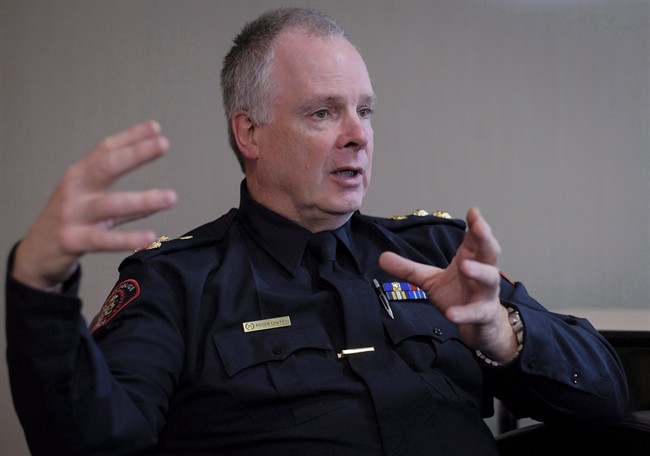Calgary’s police chief says the Alberta government has to take more aggressive action on fentanyl if it wants to help addicts and families who are being destroyed.

“It is a crisis,” said Calgary Police Chief Roger Chaffin in an interview with The Canadian Press.
“Look at the numbers of deaths. Numbers of homicides and traffic fatalities don’t come anywhere near the deaths associated with these drugs.”
Watch below from Sept. 19: Fentanyl overdose paralyzes Calgary teen – ‘he has a life sentence now’

In the first 10 months of 2016, 338 Albertans died from opioid-related overdoses, with fentanyl linked to 193 of those deaths.
“People are going to keep arguing about whether this is a crisis or not. It just shocks me,” Chaffin said. “We’re wasting all our energy arguing about whether this should be called a public health crisis or not. Spend your energy fixing the problem.”
READ MORE: Opioid crisis – Calgary firefighters now equipped with life-saving naloxone kits
Chaffin said there is a huge demand for highly addictive opioids such as fentanyl — a drug used as a painkiller for terminally ill cancer patients and 100 times more powerful than heroin — or its more powerful cousin carfentanil. Reducing the supply increases the price and make its users more desperate, he said.
“We can take off dealers until we’re blue in the face and we do,” he said.
“We exhaust a lot of time looking for supplies of these drugs … but, until you deal with the demand side, until you help communities recover from that, we’ll be chasing it for a long time and see a lot more tragedies before we see any change in the game.”
Chaffin wants the government to come up with a broader strategy beyond providing the opioid antidote naloxone and creating safe injection sites.
READ MORE: Edmonton Police Service offers conditional support of safe injection sites
“We need to get these people out of the lifestyle they’re in and get them into more healthy lifestyles, improve their families, improve their wellness in this community and change the quality of life in Calgary. That won’t happen by one-off programs or relying on the police to arrest dealers,” he said.
“If I get hold of you as an addict and you want to get help and I tell you to come back in 30 days because there’s no treatment facilities — addicts don’t come back in 30 days.
READ MORE: 2016 Year in Review – Calgary Police Chief Roger Chaffin on spike in crime, police shootings
Rosalind Davis watched her partner, Nathan Huggins-Rosenthal, develop an opioid addiction after a back injury. His doctor referred him to an outpatient program.
“At that time I don’t think his addiction was that bad, he was still functioning but we waited four months for him to be admitted into that program and during that interval, his addiction went from bad to unmanageable and he found his way to illicit fentanyl,” she said.
“At that time, I do believe that it was manageable. I do believe we would have been OK.”
Huggins-Rosenthal died of an overdose in February.
Davis is disappointed with the Alberta NDP government‘s approach on opioids.
“They’re the self-proclaimed compassionate government and really we’re just seeing no changes in terms of how addiction treatment is being offered.”
READ MORE: Alberta considers radical new approach to battling fentanyl
Alberta’s associate health minister said the government is working on the problem, but it can’t solve it overnight.
“I really wish that there was a quick fix for this, but unfortunately there just isn’t. I think a key thing for us to do is to continue to expand access to opioid replacement therapy as well as other treatment models so that people are able to get the treatment that they need,” said Brandy Payne.
“We also know that not everyone is ready for treatment and moving forward on harm reduction is critical so that we are able to help people stay alive another day.”
Watch below from Dec. 6: Recovering fentanyl addict relates to Calgary parents who died from suspected drug overdose

Calgary’s Alberta Adolescent Recovery Centre offers an 8-to-12 month program for up to 30 addicted kids between the ages of 13 and 21, but its founder says there are many more who require treatment.
“It’s Russian roulette with these kids,” said executive director Dean Vause.
“It’s powerful and it’s killing them. It is the most painful, most horrible part of my career — dealing with a parent who has lost a kid to this ugly illness. The gravity of it is, some people are going to die from this. It’s out there and it’s real.”
READ MORE: Alberta Liberal leader wants more government action on fentanyl
Alberta’s Liberal leader, who co-chaired a government review on mental health services, said addiction needs to be dealt with immediately.
“What we have is a government that’s in denial,” said David Swann.
“We now have between 40,000 and 60,000 addicts in the province and we’re only managing about 2,000 to 3,000 in our clinics.”
Swann said Alberta spends just six per cent of its health budget on mental health and addiction, but many suffer from both. He said waiting up to six weeks for treatment is unacceptable.
“Once an addict decides to get care, they have to get in promptly — not four to six weeks after they’re ready. They could be worse off or dead in four to six weeks,” Swann said.
“For some reason the government either doesn’t have the resources to step it up or the political will.”

Comments